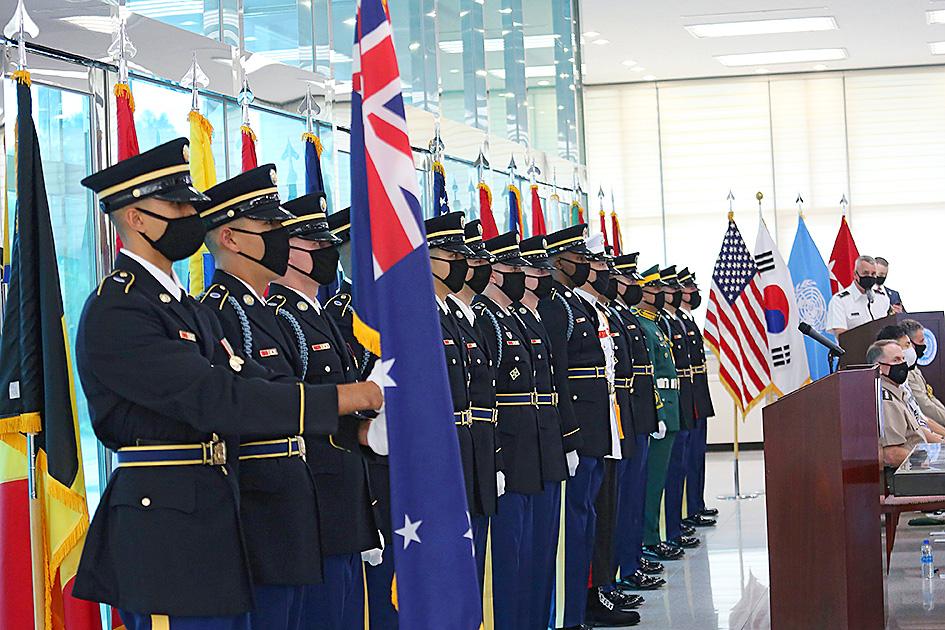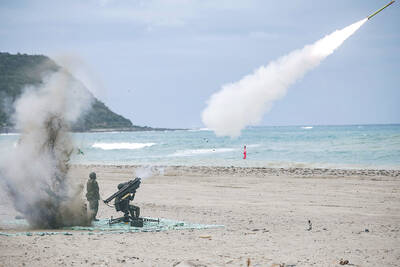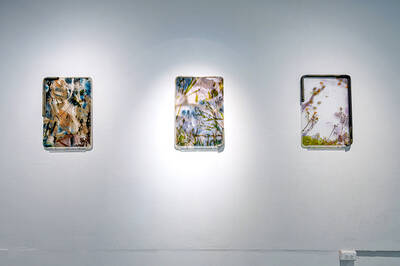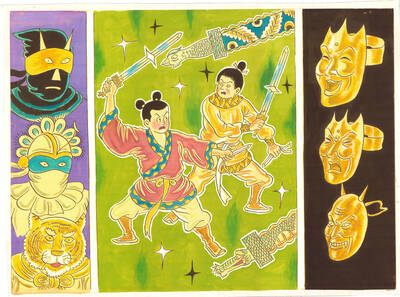North Korean leader Kim Jong-un was shown surrounded by pistol-toting generals while in the South masked veterans were socially distanced as the two sides yesterday separately marked the armistice that ended Korean War hostilities.
The contrasting events marked 67 years since the ceasefire that left the peninsula divided and millions of families split by the Demilitarized Zone.
In the North’s capital, Kim handed out commemorative pistols to dozens of generals and senior officers, who pledged their loyalty to him, state media reported.

Photo: Reuters
The North reported its first suspected case of novel coronavirus infection at the weekend — after insisting for months it had kept itself free of the disease that has swept the world — but pictures showed the generals all gathered close together for a group photo, none of them wearing masks.
In Seoul, scores of veterans — in facial coverings and socially distanced seats — attended a ceremony paying tribute to their efforts, themed “Days of Glory.”
On screen, dramatic reconstructions of the war were interspersed with interviews with foreign veterans, and messages of support from current leaders of the countries that sent troops to support the South, among them US President Donald Trump and his French counterpart Emmanuel Macron.

Photo: AFP
Millions of people were killed during the three-year conflict, which began when the Communist North invaded the US-backed South as leader Kim Il-sung — grandfather of the incumbent — sought to reunify by force the peninsula Moscow and Washington had divided at the end of World War II.
The Chinese and Soviet-backed North fought to a standstill against the South and a US-led UN coalition.
Hostilities ended on July 27, 1953 with a ceasefire that has never been replaced by a peace treaty.
The North has subsequently built up a nuclear arsenal that it says it needs to protect itself against a US invasion, and has been subjected to multiple international sanctions as a result.
Pyongyang regards the conflict — which it calls the Glorious Fatherland Liberation War — as a victory and the official news agency KCNA reported that Kim presented his generals at the weekend with “commemorative pistols bearing his august name in token of his trust.”
The weapons were named after Mount Paektu, the dormant volcano on the Chinese-Korean border that is regarded as the spiritual birthplace of the Korean people.
In the pictures, the chief of the general staff Vice Marshal Pak Jong-chon, who was sitting to Kim’s right, carefully pointed his pistol upwards rather than towards the leader.
In Seoul’s futuristic Zaha Hadid-designed Dongdaemun Design Plaza, General Robert Abrams, the commander of UN Command and US Forces Korea, said the war was “a great tragedy in human history” that “left the Korean peninsula in rubble” and “caused immense suffering for the Korean people.”
The US stations 28,500 troops in the South and he added: “Freedom is not free and neither is peace.”

In late October of 1873 the government of Japan decided against sending a military expedition to Korea to force that nation to open trade relations. Across the government supporters of the expedition resigned immediately. The spectacle of revolt by disaffected samurai began to loom over Japanese politics. In January of 1874 disaffected samurai attacked a senior minister in Tokyo. A month later, a group of pro-Korea expedition and anti-foreign elements from Saga prefecture in Kyushu revolted, driven in part by high food prices stemming from poor harvests. Their leader, according to Edward Drea’s classic Japan’s Imperial Army, was a samurai

Located down a sideroad in old Wanhua District (萬華區), Waley Art (水谷藝術) has an established reputation for curating some of the more provocative indie art exhibitions in Taipei. And this month is no exception. Beyond the innocuous facade of a shophouse, the full three stories of the gallery space (including the basement) have been taken over by photographs, installation videos and abstract images courtesy of two creatives who hail from the opposite ends of the earth, Taiwan’s Hsu Yi-ting (許懿婷) and Germany’s Benjamin Janzen. “In 2019, I had an art residency in Europe,” Hsu says. “I met Benjamin in the lobby

April 22 to April 28 The true identity of the mastermind behind the Demon Gang (魔鬼黨) was undoubtedly on the minds of countless schoolchildren in late 1958. In the days leading up to the big reveal, more than 10,000 guesses were sent to Ta Hwa Publishing Co (大華文化社) for a chance to win prizes. The smash success of the comic series Great Battle Against the Demon Gang (大戰魔鬼黨) came as a surprise to author Yeh Hung-chia (葉宏甲), who had long given up on his dream after being jailed for 10 months in 1947 over political cartoons. Protagonist

Peter Brighton was amazed when he found the giant jackfruit. He had been watching it grow on his farm in far north Queensland, and when it came time to pick it from the tree, it was so heavy it needed two people to do the job. “I was surprised when we cut it off and felt how heavy it was,” he says. “I grabbed it and my wife cut it — couldn’t do it by myself, it took two of us.” Weighing in at 45 kilograms, it is the heaviest jackfruit that Brighton has ever grown on his tropical fruit farm, located